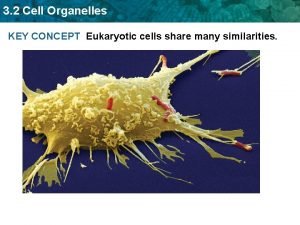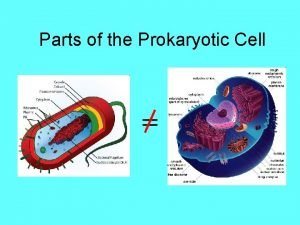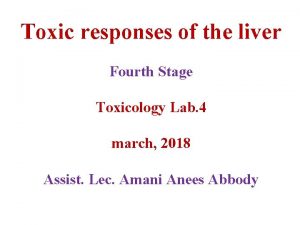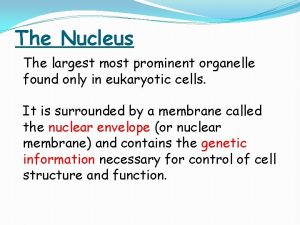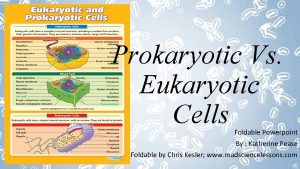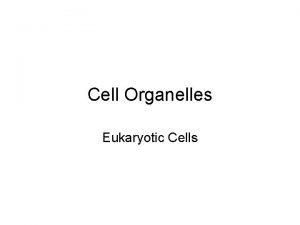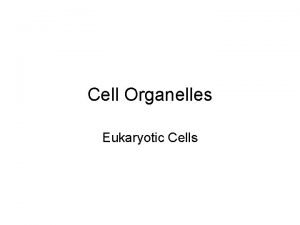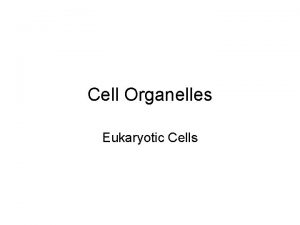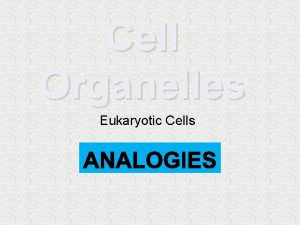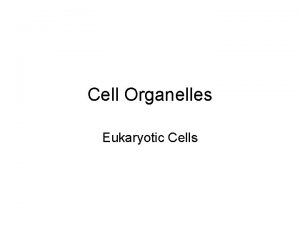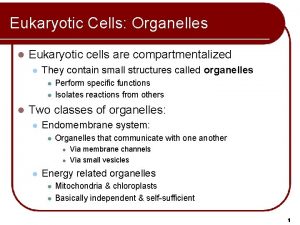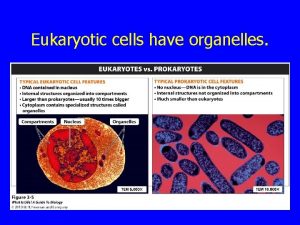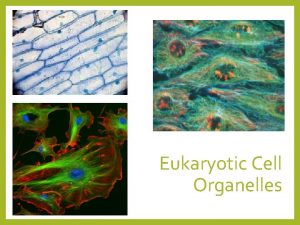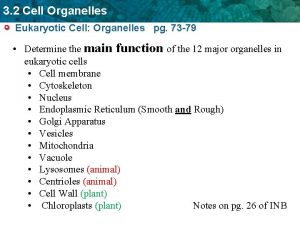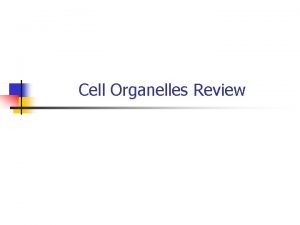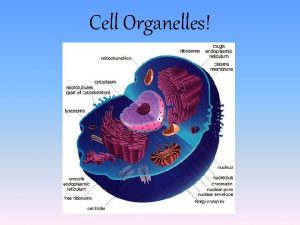Cell Organelles Eukaryotic Cells Cell Parts Cells the















- Slides: 15

Cell Organelles Eukaryotic Cells

Cell Parts • Cells – the basic unit of life. • Organelles - small structures inside a cell with specific functions.

A) Cell Membrane/Plasma Membrane Cell membrane 1. Function: Regulates materials entering and exiting the cell and serves as a boundary from outside environment. 2. Structure: Two layers of phospholipids, proteins

B) Cytoplasm 1. Function: All cell contents that lie between the cell membrane and the nucleus. (organelles + cytosol) a. Cytosol = liquid portion/non-organelles. 2. Structure: Made up of fluid and organelles except for nucleus

C) Nucleus 1. Function: Controls most of a cell’s processes and stores DNA. 2. Structure: Membrane bound, contains DNA

G) Endoplasmic Reticulum Rough ER Smooth ER Function and Structure: a. Rough ER: A membrane system with ribosomes on its surface where proteins are assembled. b. Smooth ER: A membrane system where lipids are assembled.

H) Ribosomes Free Ribosomes 1. Function: Makes proteins. 2. Structure: Small circular organelles

J) Lysosomes 1. Function: Packets of enzymes that break down materials in a cell. 2. Structure: Small membrane-bound organelles

K) Mitochondria 1. Function: Produce energy for the cell – site of cellular respiration. 2. Structure: Double membrane-bound, kidney shaped, contains its own DNA

L) Golgi Apparatus 1. Function: Modifies, sorts, and packages proteins. 2. Structure: Pancake-shaped layered organelle

M) Cytoskeleton Microfilaments Microtubules 1. Function: Provide support and structure for the cell. 2. Structure: Microtubules and microfilaments

P) Chloroplasts (Plants only) Chloroplasts 1. Function: site of photosynthesis (converting sun and CO 2 into sugar). 2. Structure: Membrane bound organelles that contain chlorophyll

Q) Cell Wall (Plants only) Cell Wall 1. Function: Provides support for the cell and the plant. 2. Structure: Made of cellulose

Cell Parts Analogy • Create an analogy (besides the city analogy) for the cell and its parts • Possible ideas: – Stadium – School – Country – Restaurant – House – Mall – Waterpark

Stadium Example: • • Cell membrane: wall of stadium, gates Cytoplasm: everything inside the stadium. Nucleus: the control room for the stadium. Etc…
 Organelles in eukaryotic cells worksheet
Organelles in eukaryotic cells worksheet Cells cells they're made of organelles meme
Cells cells they're made of organelles meme Eukaryotic life
Eukaryotic life Prokaryotic cells vs eukaryotic cells venn diagram
Prokaryotic cells vs eukaryotic cells venn diagram 4 types of eukaryotic cells
4 types of eukaryotic cells Which compares prokaryotes and eukaryotes
Which compares prokaryotes and eukaryotes Parts of a prokaryotic cell
Parts of a prokaryotic cell Site:slidetodoc.com
Site:slidetodoc.com Prokaryotic and eukaryotic cells
Prokaryotic and eukaryotic cells Prokaryotic cell and eukaryotic cell
Prokaryotic cell and eukaryotic cell Carbohydrate side chain
Carbohydrate side chain Venn diagram plant and animal cell
Venn diagram plant and animal cell Liver cells organelles
Liver cells organelles Most prominent organelle in eukaryotic cells
Most prominent organelle in eukaryotic cells Eukaryotic cells
Eukaryotic cells 3 parts of the cell theory
3 parts of the cell theory
